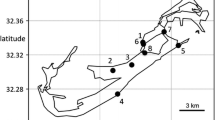Abstract
Cockburn Island, off the north-east Antarctic Peninsula, is important in the history of Antarctic terrestrial biology as it was here where the first botanical collections were made by JD Hooker in 1843. These, and a subsequent collection made by IM Lamb one hundred years later, are described here. A much more detailed survey of the vegetation of the island was made in 1989. At least nine moss, 34 lichen, three cyanobacteria and one alga taxa were recorded, and the floristic composition of several distinct communities assessed. The floristically most interesting and diverse sites are on the island's 250 m high plateau which possesses seepage areas and welldeveloped networks of polygons and stone circles. The vegetation is similar to that occurring on the mainly sedimentary deposits and rocks of nearby James Ross and Seymour Islands, but significantly different to that on the more acidic soils and rocks which predominate throughout much of the maritime Antarctic.
Similar content being viewed by others
References
Andersson JG (1906) On the geology of Graham Land. Bull Geol Inst, Univ Uppsala 7:19–71
Broady PA (1979) The terrestrial algae of Signy Island, South Orkney Islands. Br Antarct Surv Sci Reps 98:1–117
Cardot J (1908) La flore bryologique des Terres Magellaniques, de la Géorgie du Sud et de l'Antarctide. Wiss Ergebn Südpolarexp 1901–03 Bd 4, Lf 8:1–298
Darbishire OV (1912) The lichens of the Swedish Antarctic Ex- pedition. Wiss Ergebn Südpolarexp 1901–03 Bd 4, Lf 11:1–74
Gimingham CH, Smith RI Lewis (1970) Bryophyte and lichen communities in the maritime Antarctic. In: Holdgate MW (ed) Antarctic Ecology 2:752–785. Academic Press, London
Greene DM (1986) A conspectus of the mosses of Antarctica, South Georgia, the Falkland Islands and southern South America. British Antarctic Survey, Cambridge: 1–314
Hooker JD (1847) Flora Antarctica. Part II. Botany of Fuegia, The Falklands, Kerguelen's Land, etc. In: The Botany The Antarctic Voyage of H. M. Discovery Ships Erebus and Terror, in the years 1839–1843. Under the command of Captain Sir James Clark Ross. Reeve Brothers, London
Hooker JD, Taylor T (1844) Lichenes Antarctici; being characters and brief descriptions of the new Lichens discovered in the Southern circumpolar regions, Van Diemen's Land and New Zealand, during the Voyage of H.M. Discovery Ships Erebus and Terror. Lond J Bot 3:634–658
James D (1949) That Frozen Land. (The story of a year in the Antarctic). The Falcon Press, London
Jones PD, Limbert DWS (1987) A data bank of Antarctic surface temperature and pressure data. US Dept of Energy, Washington R038, DOE/ER/60397-H2, Dist. Category UC-11:1–52
Lamb IM (1945) Operation Tabarin. Personal Diary of Dr I Mackenzie Lamb. Br Antarct Surv Archives, AD6/ID/1945/82:90–176
Lamb IM (1948) Antarctic pyrenocarp lichens. Discovery Reps 25:1–30
Lightowlers PJ (1986) The moss genus Tortula from the Antarctic Botanical Zone. Br Antarct Surv Bull 72:71–76
Lightowlers PJ (1988) The Antarctic Plant Database and the BAS Herbarium. Taxon 37:378–380
Kanda H (1981) Two moss species of the genus Pottia collected from the vicinity of Syowa Station, East Antarctica. Antarct Res 71:96–108
Nordenskjöld NOG, Andersson JG (1905) Antarctica or Two years amongst the ice of the South Pole. Hurst and Blackett Ltd, London
Ochyra R, Vitt DH, Horton DG (1986) An annotated guide to Bryophyta Antarctica Exsiccata. Cryptogamie, Bryol. Lichénol 7:53–62
Skottsberg C (1912) Die vegetationsverhaltnisse des Graham Landes. Wiss Ergebn Schwed Südpolarexp 1901–1903 Bd 4, Lf 13:1–15
Smith RI Lewis (1972) Vegetation of the South Orkney Islands with particular reference to Signy Island. Br Antarct Surv Sci Reps 64:1–124
Smith RI Lewis (1984) Terrestrial plant biology of the sub-Antarctic and Antarctic. In: Laws RM (ed) Antarctic Ecology 1:61–162. Academic Press, London
Smith RI Lewis (1988) Botanical survey of Deception Island. Br Antarct Surv Bull 80:129–136
Smith RI Lewis, Gimingham CH (1976) Classification of cryptogamic communities in the maritime Antarctic. Br Antarct Surv Bull 43:25–47
Søchting U, Øvstedal DO (1992) Contribution to the Caloplaca flora of the western Antarctic region. Nord J Bot 12:121–134
Walker FJ (1985) The lichen genus Usnea subgenus Neuropogon. Bull Br Museum (Nat Hist), Botany Ser 13:1–130
Zinsmeister WJ, Webb P-N (1982) Cretaceous-Tertiary geology and paleontology of Cockburn Island. Ant J US 17, No. 5:41–42
Author information
Authors and Affiliations
Rights and permissions
About this article
Cite this article
Lewis Smith, R.I. The vegetation of Cockburn Island, Antarctica. Polar Biol 13, 535–542 (1993). https://doi.org/10.1007/BF00236395
Received:
Accepted:
Issue Date:
DOI: https://doi.org/10.1007/BF00236395




